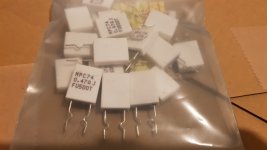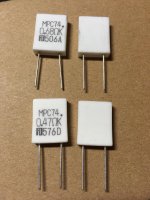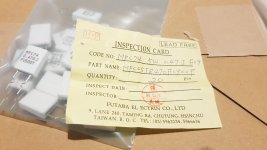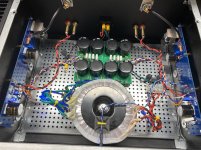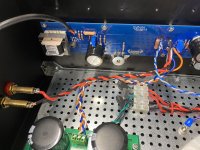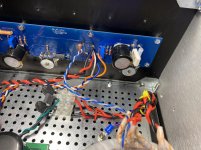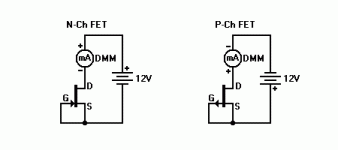Hi 2 picoDumbs,
did you compare the Vishay and Panasonic with Futaba MPC74 ? Or some of the other Futaba MPCs (e.g., 70, 75, 76 ...).
I'm asking because I looked at the data sheets on RS and Conrad.de. The distributor claims in the German version of the data sheet for MPC74 and MPC 78 lower distortion and lower noise than for the other variants because of their "non-magnetic nature", marking them specially for audio use ...
It's in this one, on the bottom of page one of the data sheet:
Fukushima Futaba MPC74 5W 0,47 Ohm 5% Metal film resistor 0.47 Ω Radial lead MPC74 5 W 5 % 1 pc(s) | Conrad.com
Not in the English version on RS:
MPC74 0R22 J | Fukushima Futaba 220mΩ Metal Plate Metal Plate Resistor 5W +-5% MPC74 0R22 J | RS Components
Haven't found the data sheet by Futaba themselves, and I find it curious that the distributor is making this claim only in the German version of the data sheet ... 😛
Best regards, Claas
did you compare the Vishay and Panasonic with Futaba MPC74 ? Or some of the other Futaba MPCs (e.g., 70, 75, 76 ...).
I'm asking because I looked at the data sheets on RS and Conrad.de. The distributor claims in the German version of the data sheet for MPC74 and MPC 78 lower distortion and lower noise than for the other variants because of their "non-magnetic nature", marking them specially for audio use ...
It's in this one, on the bottom of page one of the data sheet:
Fukushima Futaba MPC74 5W 0,47 Ohm 5% Metal film resistor 0.47 Ω Radial lead MPC74 5 W 5 % 1 pc(s) | Conrad.com
Not in the English version on RS:
MPC74 0R22 J | Fukushima Futaba 220mΩ Metal Plate Metal Plate Resistor 5W +-5% MPC74 0R22 J | RS Components
Haven't found the data sheet by Futaba themselves, and I find it curious that the distributor is making this claim only in the German version of the data sheet ... 😛
Best regards, Claas
They are non-magnetic which is good, but so are Panasonic and Vishay. So there is no advantage in that regard vs Panasonic and Vishay.
What I don't like about the MPC74 resistors I measured is that there thermal behaviour is ridiculously bad. Resistance is all over the place (both positive and negative) dynamically as they heat up.
This does not occur at all with Vishay.
What I don't like about the MPC74 resistors I measured is that there thermal behaviour is ridiculously bad. Resistance is all over the place (both positive and negative) dynamically as they heat up.
This does not occur at all with Vishay.
Last edited:
I guess another way to put it, is, if MPC74 are considered good then Vishay CPF3 are orders of magnitude better eg something like 100 times measurably better. That's not an exageraion either.
Last edited:
Thanks pico, that's very interesting.
Have you looked at wirewounds as well (preferably the non-inductive variety) ?
So far, in my builds I have mostly been using Mundorf MOX power resistors. But the Vishay/Dale CPF3 metal film power resistors look very intriguing.
Best regards, Claas
Have you looked at wirewounds as well (preferably the non-inductive variety) ?
So far, in my builds I have mostly been using Mundorf MOX power resistors. But the Vishay/Dale CPF3 metal film power resistors look very intriguing.
Best regards, Claas
Hi,2 picoDumbs-san
The MPC74 in your photo seems to be different from mine.
I purchased these at an electrical parts store in Japan.
It's hard to recognize, but the product pictures of the manufacturers are the same as mine.
Metal Plate Cement Resistors | 抵抗器 ハイブリッドIC | 福島双羽電機株式会社
The MPC74 in your photo seems to be different from mine.
I purchased these at an electrical parts store in Japan.
It's hard to recognize, but the product pictures of the manufacturers are the same as mine.
Metal Plate Cement Resistors | 抵抗器 ハイブリッドIC | 福島双羽電機株式会社
Attachments
These were purchased directly from Futaba.
Here is Futaba's inspection receipt.
Says Futaba Taiwan, so I guess your ones are Futaba Japan, and mine are Futaba Taiwan.
I will try and get hold of the Futaba Japan parts to see if they are better.
Here is Futaba's inspection receipt.
Says Futaba Taiwan, so I guess your ones are Futaba Japan, and mine are Futaba Taiwan.
I will try and get hold of the Futaba Japan parts to see if they are better.
Attachments
Last edited:
Thanks pico, that's very interesting.
Have you looked at wirewounds as well (preferably the non-inductive variety) ?
Best regards, Claas
Haven't had a chance to measure wire wounds as of yet.
Says Futaba Taiwan, so I guess your ones are Futaba Japan, and mine are Futaba Taiwan.
Oh, I see. I did not know Taiwan Futaba.
Excuse me. It's written in Japanese, but I found some interesting data.
定電流回路の電流検出抵抗を試す: 居酒屋ガレージ日記
Compared to other resistors, MPC74 (maybe made in Japan) has less change in resistance value when a constant current is applied.
The change in resistance of MPC is 0.1%, but that of MOX and cement is about 1%.
Anyway, this data makes me sleep better.
 I used MPC on my amp build.
I used MPC on my amp build.If you're interested I can make a short video to show how terrible the Taiwanese made Futaba resistors are.
It is the dynamic behaviour of these resistor that concerns me the most. As they are heating up the resistance jumps around like crazy (like noise) in a complete random manner.
That doesn't happen at all with Vishay CPF3.
It is the dynamic behaviour of these resistor that concerns me the most. As they are heating up the resistance jumps around like crazy (like noise) in a complete random manner.
That doesn't happen at all with Vishay CPF3.
Last edited:
Futaba !?? they are a dying RC radio gear brand.
Why has that brand name been adopted to cheap *** resistors?
Even more curiously; Why would one Dick around with iffy resistors.. to save what... 2 maybe even a whole 4 $!
Idiocy in a word.
Why has that brand name been adopted to cheap *** resistors?
Even more curiously; Why would one Dick around with iffy resistors.. to save what... 2 maybe even a whole 4 $!
Idiocy in a word.
Last edited:
The mids/highs do seem recessed a bit on the F6. I have level controls on my speakers and always had the mids and highs set at half way with other amps. With the F6 I had to max them out.
That's odd, the F6 is well known to be very transparent and extended. Some others have had to tone down speaker crossovers over it, particularly horns. Due to this, F6 (a great amp) wasn't working out as well as others in my systems/preferences. I turned it into an Aleph J.
I intend to revisit F6, boards tucked away for now. Several have tweeked this amp in interesting ways, and I do have a spare set of Semisouths…
Russellc
That's odd, the F6 is well known to be very transparent and extended. Some others have had to tone down speaker crossovers over it, particularly horns. Due to this, F6 (a great amp) wasn't working out as well as others in my systems/preferences. I turned it into an Aleph J.
I intend to revisit F6, boards tucked away for now. Several have tweeked this amp in interesting ways, and I do have a spare set of Semisouths…
Russellc
It still sounds good - just not as good as my Fisher driving LS3/5As (my current reference). The Fisher is a match made in heaven for those speakers and has the added advantage of 16 ohm taps.
Just finished my F6 build but ran into a small problem.
Both sides of the amp biased fine to .5V, offset set to 0. I plugged in speakers and the right side is much quieter than the other. I swapped rca, swapped cables, and swapped speakers but it always came down to the right side much quieter. When I listen to just the right channel it is distorts at higher volumes.
Hoping to get any help possible.
Both sides of the amp biased fine to .5V, offset set to 0. I plugged in speakers and the right side is much quieter than the other. I swapped rca, swapped cables, and swapped speakers but it always came down to the right side much quieter. When I listen to just the right channel it is distorts at higher volumes.
Hoping to get any help possible.
Attachments
From a reputable seller. I have a friend with an audio store here in Houston that received a large amount of kits from a customer they included a lot of matched pairs of Toshiba JFETs. I’ve used quite a few of them in builds with 0 issues but maybe this pair could be a dud?
Any way to test them while hooked up?
If I replace them, do I need to replace both channels or can one side be a different matched pair?
Any way to test them while hooked up?
If I replace them, do I need to replace both channels or can one side be a different matched pair?
- Home
- Amplifiers
- Pass Labs
- F6 Illustrated Build Guide
